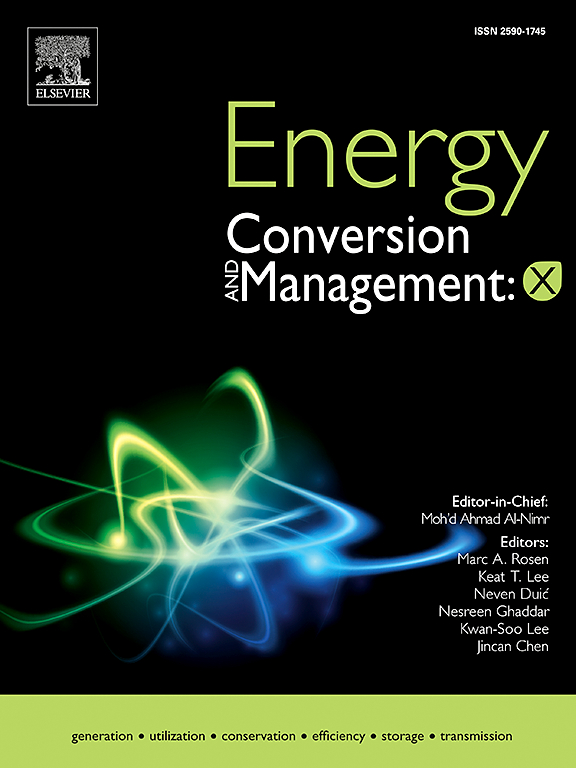Exploring the carbon-green certificate market conversion path: Application validation in a solar-biomass-driven integrated energy system
IF 10.9
1区 工程技术
Q1 ENERGY & FUELS
引用次数: 0
Abstract
Carbon-green certificate markets advance emission reduction goals, drive energy transitions, and enhance resource allocation efficiency. Despite extensive studies on integrated energy systems (IES) participation in multi-markets, research on the distinctions and interrelations of IES participation in different markets remains relatively scarce. Consequently, a solar-biomass-driven IES is created to explore the conversion path for biomass power generation to participate in the carbon-green certificate market. The proposed system combines renewable energy generation devices with gas-fired units, enabling it to participate in the carbon-green certificate market. Then, a novel criterion is proposed for biogas-driven gas-fired power generation units to participate in the carbon-green certificate market. Subsequently, this study employs pre-combustion carbon capture technologies to enable the IES to comply with the criterion of the proposed conversion path. Finally, considering the economic and environmental implications of the carbon-green certificate market, a multi-objective optimization model incorporating a ladder-negative carbon price is developed to investigate the Pareto frontier of different objectives. Compared to the reference case of biomass power generation participating in the green certificate market, the proposed market conversion method expands the Pareto frontier of IES. The carbon emission boundary extends to (−10.80 %, 122.86 %), while the cost boundary ranges (−10.32 %, −7.67 %). With the introduction of the ladder-negative carbon price, the carbon emission boundary is adjusted to (−12.63 %, 80.37 %), and the cost boundary improves to (−11.31 %, −7.05 %), demonstrating a further optimization of the Pareto frontier.

探索碳绿色证书市场转换路径:在太阳能-生物质驱动的综合能源系统中的应用验证
碳绿色证书市场推进了减排目标,推动了能源转型,提高了资源配置效率。尽管对综合能源系统(IES)参与多市场进行了广泛的研究,但对不同市场的IES参与的区别和相互关系的研究仍然相对较少。因此,创建了太阳能-生物质驱动的IES,探索生物质发电参与碳绿色证书市场的转换路径。拟议中的系统将可再生能源发电设备与燃气发电设备相结合,使其能够参与碳绿色证书市场。在此基础上,提出了沼气驱动燃气发电机组参与碳绿色证书市场的新标准。随后,本研究采用燃烧前碳捕获技术,使IES符合所提出的转化路径标准。最后,考虑到碳绿色证书市场的经济和环境影响,建立了一个包含阶梯负碳价的多目标优化模型来考察不同目标下的帕累托边界。与生物质发电参与绿色证书市场的参考案例相比,本文提出的市场转换方法拓展了IES的帕累托边界。碳排放边界延伸至(- 10.80%,122.86%),成本边界延伸至(- 10.32%,- 7.67%)。引入阶梯负碳价后,碳排放边界调整为(- 12.63%,80.37%),成本边界调整为(- 11.31%,- 7.05%),进一步优化了帕累托边界。
本文章由计算机程序翻译,如有差异,请以英文原文为准。
求助全文
约1分钟内获得全文
求助全文
来源期刊

Energy Conversion and Management
工程技术-力学
CiteScore
19.00
自引率
11.50%
发文量
1304
审稿时长
17 days
期刊介绍:
The journal Energy Conversion and Management provides a forum for publishing original contributions and comprehensive technical review articles of interdisciplinary and original research on all important energy topics.
The topics considered include energy generation, utilization, conversion, storage, transmission, conservation, management and sustainability. These topics typically involve various types of energy such as mechanical, thermal, nuclear, chemical, electromagnetic, magnetic and electric. These energy types cover all known energy resources, including renewable resources (e.g., solar, bio, hydro, wind, geothermal and ocean energy), fossil fuels and nuclear resources.
 求助内容:
求助内容: 应助结果提醒方式:
应助结果提醒方式:


